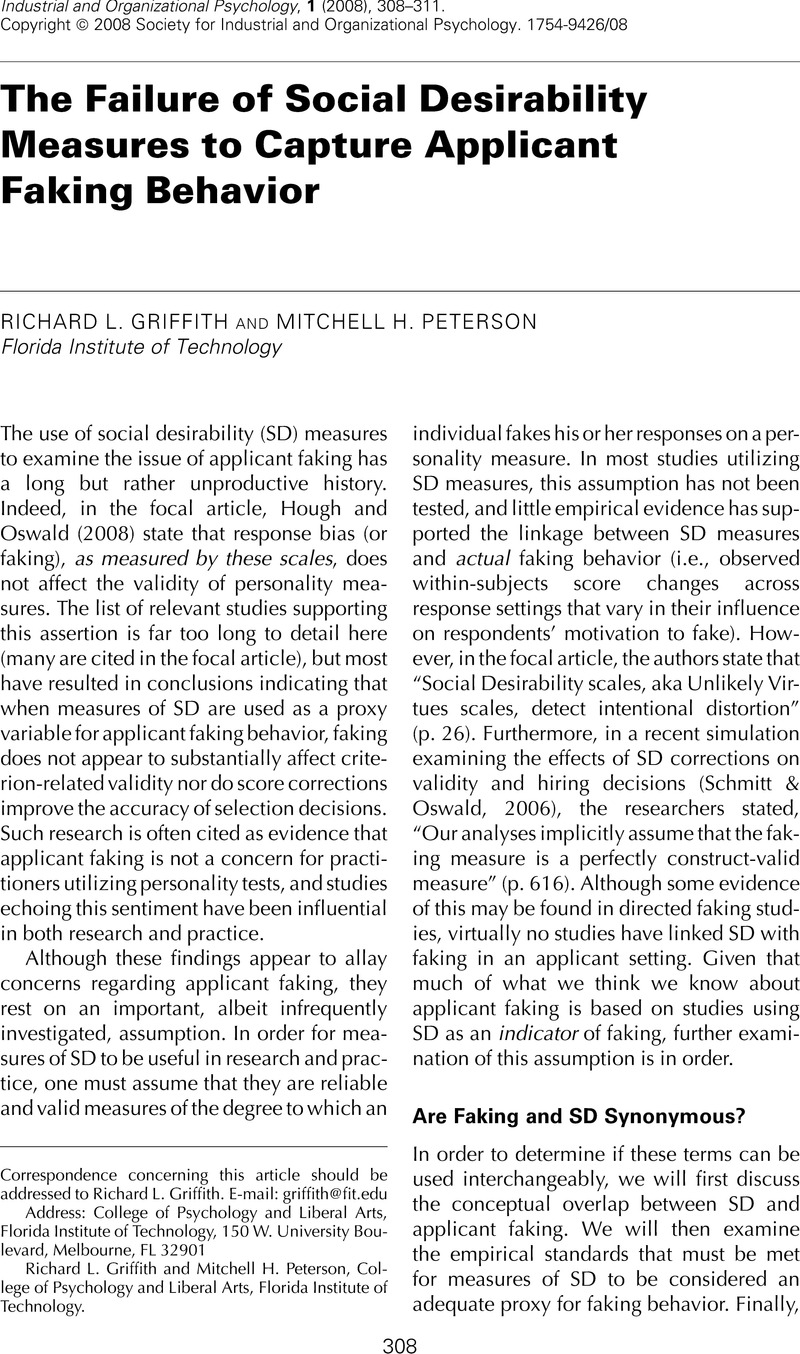Crossref Citations
This article has been cited by the following publications. This list is generated based on data provided by Crossref.
Oswald, Frederick L.
and
Hough, Leaetta M.
2008.
Personality Testing and Industrial–Organizational Psychology: A Productive Exchange and Some Future Directions.
Industrial and Organizational Psychology,
Vol. 1,
Issue. 3,
p.
323.
Gueutal, Hal G.
Kluemper, Donald H.
and
Rosen, Peter A.
2009.
Future employment selection methods: evaluating social networking web sites.
Journal of Managerial Psychology,
Vol. 24,
Issue. 6,
p.
567.
O’Neill, Thomas A.
Goffin, Richard D.
and
Gellatly, Ian R.
2010.
Test-Taking Motivation and Personality Test Validity.
Journal of Personnel Psychology,
Vol. 9,
Issue. 3,
p.
117.
Detrick, Paul
Chibnall, John T.
and
Call, Cynthia
2010.
Demand Effects on Positive Response Distortion by Police Officer Applicants on the Revised NEO Personality Inventory.
Journal of Personality Assessment,
Vol. 92,
Issue. 5,
p.
410.
Peterson, Mitchell H.
Griffith, Richard L.
Isaacson, Joshua A.
O'Connell, Matthew S.
and
Mangos, Phillip M.
2011.
Applicant Faking, Social Desirability, and the Prediction of Counterproductive Work Behaviors.
Human Performance,
Vol. 24,
Issue. 3,
p.
270.
Kuncel, Nathan R.
Goldberg, Lewis R.
and
Kiger, Tom
2011.
A Plea for Process in Personality Prevarication.
Human Performance,
Vol. 24,
Issue. 4,
p.
373.
Bing, Mark N.
Kluemper, Don
Kristl Davison, H.
Taylor, Shannon
and
Novicevic, Milorad
2011.
Overclaiming as a measure of faking.
Organizational Behavior and Human Decision Processes,
Vol. 116,
Issue. 1,
p.
148.
Ferrando, Pere Joan
and
Anguiano-Carrasco, Cristina
2011.
A Structural Equation Model at the Individual and Group Level for Assessing Faking-Related Change.
Structural Equation Modeling: A Multidisciplinary Journal,
Vol. 18,
Issue. 1,
p.
91.
Ferrando, Pere J.
and
Anguiano-Carrasco, Cristina
2011.
Faking propensity and faking-related change: A model-based analysis of the EPQ-R scores.
Personality and Individual Differences,
Vol. 51,
Issue. 4,
p.
497.
König, Cornelius J.
Merz, Ann‐Sibill
and
Trauffer, Nicoletta
2012.
What is in Applicants' Minds When They Fill Out a Personality Test? Insights from a qualitative study.
International Journal of Selection and Assessment,
Vol. 20,
Issue. 4,
p.
442.
Ziegler, Matthias
Kemper, Christoph
and
Rammstedt, Beatrice
2013.
The Vocabulary and Overclaiming Test (VOC-T).
Journal of Individual Differences,
Vol. 34,
Issue. 1,
p.
32.
Ferrando, Pere J.
and
Anguiano-Carrasco, Cristina
2013.
A Structural Model–Based Optimal Person-Fit Procedure for Identifying Faking.
Educational and Psychological Measurement,
Vol. 73,
Issue. 2,
p.
173.
Chapman, Benjamin P.
Weiss, Alexander
Barrett, Paul
and
Duberstein, Paul
2013.
Hierarchical structure of the Eysenck Personality Inventory in a large population sample: Goldberg’s trait-tier mapping procedure.
Personality and Individual Differences,
Vol. 54,
Issue. 4,
p.
479.
Galić, Zvonimir
and
Jerneić, Željko
2013.
Measuring Faking on Five-Factor Personality Questionnaires.
Journal of Personnel Psychology,
Vol. 12,
Issue. 3,
p.
115.
Levashina, Julia
Weekley, Jeff A.
Roulin, Nicolas
and
Hauck, Erica
2014.
Using Blatant Extreme Responding for Detecting Faking in High‐stakes Selection: Construct validity, relationship with general mental ability, and subgroup differences.
International Journal of Selection and Assessment,
Vol. 22,
Issue. 4,
p.
371.
Uziel, Liad
2014.
Impression Management (“Lie”) Scales Are Associated With Interpersonally Oriented Self‐Control, Not Other‐Deception.
Journal of Personality,
Vol. 82,
Issue. 3,
p.
200.
Ziegler, Matthias
Maaß, Ulrike
Griffith, Richard
and
Gammon, Amy
2015.
What Is the Nature of Faking? Modeling Distinct Response Patterns and Quantitative Differences in Faking at the Same Time.
Organizational Research Methods,
Vol. 18,
Issue. 4,
p.
679.
Chang, JaeYoon
and
Nam, Sanghee
2015.
The moderating effects of Social Desirability responding on the criterion-related validity of self-report personality inventory.
Korean Journal of Industrial and Organizational Psychology,
Vol. 28,
Issue. 2,
p.
151.
Chang, JaeYoon
and
Nam, Sanghee
2015.
The moderating effects of Social Desirability responding on the criterion-related validity of self-report personality inventory.
Korean Journal of Industrial and Organizational Psychology,
Vol. 28,
Issue. 2,
p.
151.
Feeney, Justin R.
and
Goffin, Richard D.
2015.
The Overclaiming Questionnaire: A good way to measure faking?.
Personality and Individual Differences,
Vol. 82,
Issue. ,
p.
248.





